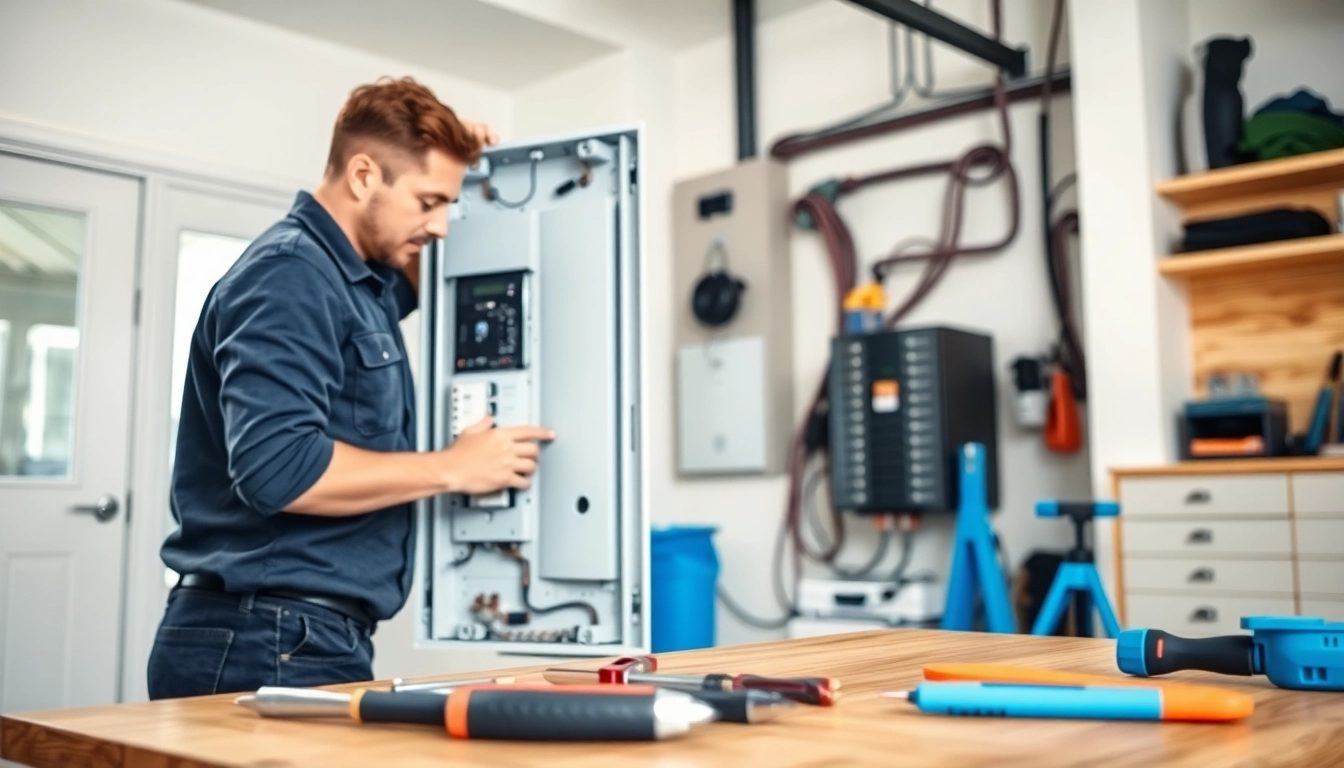Understanding the Basics of the Electrical Panel
Definition and Purpose of the Electrical Panel
An Electrical Panel, often referred to as a breaker box or distribution board, serves as the crucial hub of your home’s electrical system. This central unit manages the distribution of electricity from the utility provider to various circuits throughout the home. By controlling the flow of electricity, the electrical panel helps ensure that your devices receive the correct voltage while also protecting against potential overloads or short circuits.
Components of an Electrical Panel
An electrical panel consists of several key components that work in tandem:
- Main Breaker: This component acts as the master switch, controlling the power flow to the entire panel. It is designed to trip and cut off power in case of a fault, thereby preventing electrical fires.
- Circuit Breakers: Inside the panel, these smaller switches protect individual circuits by tripping when there’s an overload, ensuring the safety of your wiring and devices.
- Bus Bars: These conductive strips distribute electricity from the main breaker to the circuit breakers across different circuits in the panel.
- Grounding Bus: This feature is essential for safety, providing a path for electrical faults to be safely discharged to the ground.
- Neutral Bus: This bus collects the neutral wires from different circuits, returning current to the electric supply safely.
How Electrical Panels Function in Your Home
The operation of your Electrical Panel begins when electricity from the utility company enters your home. The panel functions as the main point of entry for this electricity:
- Electricity flows into the panel from the power lines.
- The main breaker allocates power to individual circuits through circuit breakers.
- Each circuit breaker corresponds to specific areas of your home, such as outlets, lighting, or large appliances.
- If a circuit experiences an overload, the corresponding circuit breaker trips, stopping the flow of electricity to protect appliances and wiring.
- The grounding and neutral buses ensure any excess or faulty current is correctly redirected, enhancing safety.
Signs You Need to Upgrade Your Electrical Panel
Indicators of Insufficient Power Supply
Modern households have a significantly higher demand for electricity due to advanced technology and various appliances. Here are some signs indicating that your current Electrical Panel might be insufficient:
- Frequent tripping of circuit breakers or blown fuses.
- Inability to run multiple appliances simultaneously without issues.
- Lights that flicker or dim, especially when large appliances turn on.
- Installation of new appliances that require more power than your existing system can handle.
Common Safety Issues Linked to Old Electrical Panels
Old or outdated electrical panels can lead to numerous safety hazards:
- Overheating: As circuit breakers become less effective, overheating is a real risk, which can lead to electrical fires.
- Corrosion and Damage: Electrical panels can suffer from physical damage or corrosion over time, increasing the risk of failure.
- Insufficient Grounding: Older panels may not have modern grounding practices, increasing shock hazards.
- Incompatible Circuit Breakers: Using mismatched or outdated breakers can leave your home vulnerable to significant safety threats.
New Appliance Needs and Electrical Load Calculation
When upgrading, it is vital to understand the overall electrical demand of your household. The electrical load is the total amount of electricity that will be used by your home’s appliances and systems, and calculating this will help determine whether an upgrade to your Electrical Panel is necessary:
- List all major appliances (e.g., refrigerators, washers, dryers, and HVAC systems) and their power requirements (measured in watts).
- Add additional load from smaller devices (lighting, electronics, etc.).
- Consider potential future needs, such as the addition of electric vehicles or smart home devices.
- Ensure that your panel can handle this total demand adequately.
Choosing the Right Electrical Panel for Your Needs
Selecting the Appropriate Amp Rating
The amp rating of an electrical panel indicates its capacity to handle electrical load. Common ratings for residential panels include 100, 150, and 200 amps:
- 100 Amp: Suitable for smaller homes or less energy-demanding households.
- 150 Amp: Ideal for mid-sized homes with several modern appliances.
- 200 Amp: The standard for newer homes or those requiring high electrical load, such as electric heating and air conditioning.
Understanding Panel Types and Features
There are a few distinct types of electrical panels available, each suited for specific applications:
- Main Breaker Panels: These contain a single main breaker that controls power to all circuits; they are the most common in residential settings.
- Sub-Panels: These are secondary panels used to distribute electricity to a specific area or to supplement the main panel’s capacity.
- Smart Panels: Advanced panels that offer monitoring capabilities and integrated technology to manage energy consumption more efficiently.
Factors Influencing Electrical Panel Costs
The cost of upgrading or installing a new Electrical Panel can vary based on several factors:
- Size and amp rating of the panel.
- Complexity of the installation (e.g., if rewiring is needed).
- Labor costs in your region.
- Any necessary upgrades to the electrical service coming into your home.
The Installation Process of an Electrical Panel
Preparing for the Installation
Before undertaking an installation, it’s important to take the following preparatory steps:
- Obtain Necessary Permits: Check with your local building department to determine what permits are required.
- Choose a Qualified Electrician: Select an experienced professional to ensure safe and compliant installation.
- Prepare Your Space: Clear the area around your existing panel to facilitate easy access during the installation.
Steps to Install the Electrical Panel
The installation process involves several critical steps:
- Power Shutdown: The old panel is de-energized to ensure safety.
- Disconnecting the Old Panel: Carefully remove all circuits and disconnect the old panel, ensuring the wiring is properly labeled.
- Installing the New Panel: Mount the new panel securely, following all manufacturer and local codes for alignment and grounding.
- Wiring the Circuits: Connect each circuit to the new panel, ensuring proper connections and secure attachments.
- Testing: After installation, the electrician will conduct thorough testing to ensure functionality and safety.
Common Pitfalls to Avoid During Installation
To ensure a smooth installation process, be mindful of these common mistakes:
- Failing to check local codes and regulations may lead to non-compliance issues.
- Underestimating the current load requirements can lead to future performance issues.
- Neglecting safety precautions can expose you to hazardous situations, including electrical shocks.
Maintenance and Upkeep of Your Electrical Panel
Routine Inspections and Safety Checks
Regular maintenance of your Electrical Panel is essential for ensuring reliability and safety:
- Inspect for signs of rust, corrosion, or damage, particularly around breakers and wiring.
- Check that circuit breakers are functioning correctly; any breaker that frequently trips should be evaluated.
- Ensure there is no dust buildup, as it can be a fire hazard.
Signs Your Electrical Panel Needs Attention
Watch for warning signs that indicate your panel might require professional attention:
- Burning smells, which can mean that your panel is overheating or wiring is failing.
- Visible signs of damage or scorching around breakers.
- Inconsistent power supply or flickering lights.
Best Practices for Long-term Panel Performance
To extend the lifespan and efficiency of your Electrical Panel, consider the following tips:
- Limit the number of devices connected to one circuit to prevent overload.
- Keep the panel tidy with organized wiring and labels for each circuit.
- Schedule annual inspections with a certified electrician to proactively detect issues.


